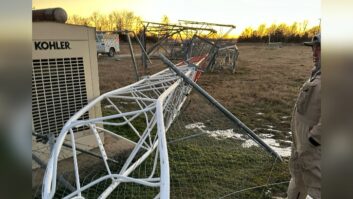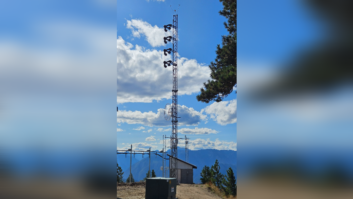A Primer to Help You Prepare for That Next NIMBY Fight – or Avoid It Altogether
Zoning ResourcesYour local ordinance can be found online at http://fws.municode.com.
A hardbound copy of your local code generally is available by request from the zoning department.
The FCC Towair program locates nearby public airports. Find it at http://gullfoss2.fcc.gov/cgi-bin/ws.exe/genmen/tow_air.hts.
Nearby towers in the FCC tower base can be found at www.berkana.com/tower.php3.
Many counties maintain a map of the towers in their area. This information is available through their GIS department. You may find any AM stations within two miles (or any other radius) at www.fcc.gov/mmb/asd/amq.html.
The process for getting a new tower approved can be scary. Let’s take a look at steps that will improve your odds for approval.
Speaking broadly, you will first do your homework. Then you’ll make preliminary contacts with the zoning board, assemble your team, prepare your application and finally appear for your meeting.
Local boards are looking for a showing of need, public benefit and harmlessness. They also want to know how your structure fits in with the current and planned zoning for the area. Will it be aesthetically pleasing? Does it pose any threat to the safety or disturb the peace of the neighborhood?
You will be arguing that your tower is the best way to achieve your goal, that your tower serves the public interest and that it will create no harm for your neighbors or workers.
Site selection
Suppose you have an AM station. Why is the site you chose the best? You will need to convince the board that you only have a limited area in which to move, that you have considered alternative locations and that you ruled them out for good reasons.
Your engineer will be helpful; he can tell you the boundaries of where your AM will fit. It needs to serve the community of license and protect other stations. In many cases there is only a limited area where the station can go.Would a move from your proposed site reduce the number of people served? Will it reduce the coverage of your community of license?
Depending on the antenna height, the number of properties on which you can build likely will be limited. Taller towers normally mean larger parcels of land to satisfy the fall zone and setback requirements. In most cases, collocation will not be feasible because tower operators will not accept the potential interference from an AM. The public-interest aspect of the station should be noted. In many applications more than one station is affected.
Does your station support emergency services? Will the antenna be available for police or fire service repeaters? Does the station have a track record for serving the public? There may be FAA constraints. Be sure to secure a copy of their “determination of no hazard” to include in your application.
NIMBY issues
It is relatively easy to show that a proposed tower will not depress property values by noting home sales in similar areas before and after a tower is erected. This typically is documented by a certified land appraiser who can answer questions about his findings. Alternately, you may find documents about towers and land values already on file with previous tower applications.
Learn as much as you can about the commissioners who will hear your application. Their vote usually is a matter of public record. You can ask for the transcripts of past tower cases and read the comments of each commissioner. Look for pet peeves and usual questions posed to prior applicants. Also note successful responses to those questions.
You will need a copy of the locality’s tower ordinance and a site plan. Look through the ordinance. Does it have different approaches to broadcasters and wireless providers (cellular or PCS)? The needs and requirements for broadcasters and wireless providers generally differ. Most of the time, cellular applicants are subject to far more stringent rules. In many cases, pointing out that you are a broadcast applicant will work to your advantage.
I have noticed that successful tower operators maintain good rapport with local government staff and board members. It never hurts to start off as friends.
You will need to determine the current zoning on the proposed property. Depending on the county, you may be able to find this information on the Internet. The tax collector, zoning office and the GIS (digitized mapping system) office are likely candidates. A quick phone call to the zoning office will get you started in the right direction. The fastest way for them to help is via your legal description, which is normally part of your site plan drawing. A street address is also a good start.
Then what?
Once your research is done, contact the zoning administrator for an informal meeting to discuss your proposal.
A map showing the location of the property, a sketch of the tower and a site plan are essential. During this meeting you will be able to determine whether or not the tower will receive favorable reception. Bring along a “people” person who is good at reading others.
Some local governments have RF engineers on retainer or staff. Such a person can be an excellent resource. He or she can evaluate your proposal and give you information concerning the outlook and possibly how to overcome weaknesses in your application.
Be prepared to justify the tower’s height and location from a technical standpoint. Saying “it’s proprietary” will immediately arouse suspicion and may turn victory into defeat. Remember that documents filed with the FCC and FAA usually are a matter of public record.
Depending on the importance of the project and the perception of difficulty, consider hiring a good local attorney. When interviewing an attorney, ascertain that he or she has a good working relationship with the board and has a history of success in tower applications. If you do not know a good one, the site acquisition department of your local wireless company may help in some instances.
One word of caution: Don’t go to the board meeting and threaten a lawsuit. Board members earn brownie points for defending the public against absurd tower applications. If your attorney thinks it’s necessary, let her proclaim the news.
Your attorney probably will wish to assemble a team of specialists. Most experts offer sworn testimony while your attorney normally does not. Your attorney will control the presentation and may cut it short or ask for a continuance should she feel it is in your best interest. Reasons to continue (postpone) your presentation may include the absence of a board member known to be friendly to tower applications or the general mood of the board.
Your attorney may shorten the presentation if she believes she has enough votes. As with any sales presentation, too much can ruin you.
On with the show
The typical “dog and pony show” will consist of an attorney, RF engineer, property appraiser and site acquisition manager. The RF engineer will explain the necessity of the tower location and height. He will answer questions as to why alternative sites and alternative technologies were rejected.
He should be prepared with exhibits of propagation studies both at the proposed site as well as alternate sites. He should be prepared to answer questions about potential interference to other services such as telephone, stereos, TVs, etc. The board is not a technical body, so anything your engineer can do to simplify the facts will help.
Common questions involve the safety of RF and the effect of towers on birds and their migratory paths. Questions about nesting locations of endangered species can be answered by state and federal fish and wildlife services. Note that the Audubon Society is opposed to lighted towers. If you contact them for information they may show up to oppose your application.
There are eight FCC categories that would trigger an environmental impact assessment. If there is any question in your mind about these categories, write to the appropriate agency. Their response, in letter form, generally dispels doubts in the mind of the board.
It normally takes some time to get a response so write as soon as you are committed to build on the site you have selected.
Wilderness areas are handled by the National Park Service. Questions concerning wildlife preserves and endangered species should be directed to the U.S. Dept. of Interior, Fish and Wildlife Service. Floodplain questions can be answered by the Federal Emergency Management Agency (FEMA). Questions about Indian religious sites and historic sites generally are answered by your state historic preservation office. The Army Corps of Engineers usually answers questions concerning surface features such as wetlands and floodways.
You may select an environmental firm that will contact these various sources and report the findings.
Property values
The property appraiser will answer the question, “Will this tower adversely affect the value of my home?”
One of the most common objections raised by private citizens is “The tower will cause my property to loose value.” Boards must balance the potential damage with the public interest. A certified appraiser can show that there is little or no potential damage to nearby landowners.
Other experts include land planners, structural engineers and environmental engineers. The land planner will help show that the proposed tower is consistent with the master land development plan. The structural engineer will answer questions about fall zones. In many cases the tower manufacturer will provide a letter sealed by their professional engineer answering those questions prior to the meeting.
In cases where a lengthwise fall of the tower would endanger a residence or a building used by the public, you may wish to retain a registered engineer to attend the meeting or at least write an opinion letter. This will be a call you need to make after preliminary discussions with the zoning people.
Environmental engineers and biologists can answer questions about sensitive environmental issues.
Next step
At this point you should prepare your application. If you have an attorney, he will prepare the legal portions and request help from your engineer on the technical points.
Many communities use an essay-type application. The usual response is to restate the ordinance and provide your answers after each subsection. This helps you avoid missing areas that are important to the staff or board.
Your answers should be clear and stick to the points in the ordinance. It should be neatly organized. The use of color is helpful.
The application is where you will include such items as FAA determinations, fall zone letters, tower drawings, environmental impact statements, warranty deeds, lease agreements, balloon test photos, photo simulations, statements from your RF engineer, maps of nearby towers and propagation maps.
If you do photo simulations or balloon tests, coordinate with the community government. Use their contractor. This will improve your credibility.
If you are renting land, make sure the landowner is informed of any conditions that may be placed on his land as a result of the tower. Most local governments require you to have a notarized authorization to act from the applicant if you are leasing the land.
You will probably not need all of the data assembled by the team. However, you should be prepared to answer all of the questions raised by board members. You or your attorney should meet with the zoning and planning staff to work with them answering their objections and questions in a courteous manner.
You can do it!
You can take on the responsibilities of the team. Some applicants do present their own cases and are successful.
During your initial meetings with the staff, you should begin to sense whether you need help.
Regardless of whether or not you assemble a team, you must comply with the public notice requirements in your area. This normally means mailing notices to neighbors within several hundred feet of the site property. Check with your local zoning department about the requirements. They must be followed exactly or a favorable ruling can be struck down.
This is when your neighbors find out about your plans for the first time. I wonder how much bad blood could have been avoided if the applicant had been on good terms with his neighbors before asking for approval. Your neighbors can make or break a tower application, unless your attorney is very good.
Understand the county’s perspective on this matter. Government officials have been burned on a number of occasions by speculators stating that they needed towers. Now approved towers stand with no occupants. Sites that had been approved for 150-foot structures end up with towers more than 200 feet tall.
These experiences, coupled with a five- to 10-fold increase in tower applications, have degraded the credibility of tower applicants.
Fortunately for the broadcast applicant, many tower ordinances are directed at the wireless telecommunications services as a reaction to the number of lawsuits arising out of the 1996 Telecom Act. The boards generally are sympathetic to broadcast applicants unless they have had bad experiences.
The tower industry has moved from speculation towers to “build to suit.” This move generally has been met favorably by most boards. Some of the more sophisticated boards are amending ordinances, to favor more, smaller towers as opposed to fewer, taller towers with collocation potential. Smaller structures are easier to camouflage. Surprisingly, there do not appear to be any studies that indicate that the general public even notices towers.
There is a lot of resentment by nearby landowners. Keep in mind that local elections are won or lost by narrow margins. A 200-vote swing is not uncommon.
One way to lose a commissioner’s vote is to have a number of irate neighbors from his district show up at a meeting. Being a good neighbor and interacting with the adjacent landowners before you decide on a new tower can pay off. If your tower can fall on your neighbor’s land, consider purchasing an easement. This can turn an adversary into an ally.
Remain positive throughout the meeting. Remember that you need only convince a majority of the commissioners you are right in order to gain approval. Your answers to the board’s questions should be short, simple and to the point. Reinforce important points with graphics during your initial presentation.
Normally, the applicant – you – will speak first. Members of the board may ask questions during or after your presentation. Next, members of the public will be invited to make comments or pose questions. Then the applicant has a short period for rebuttal and closing statements. This is your chance for damage control.
Once your rebuttal closes, the board will discuss the merits of your application and vote on its approval or denial. If during the meeting, it looks like you are losing by a wide margin or if a board member friendly to your case is absent, you should consider a continuance. A “maybe” is far better than a “no.”
Attempt to be cordial and candid. Overcome the temptation to argue with the public or board members who do not agree with you, and don’t gloat should you win.
Barry Magrill can be reached via e-mail to [email protected].












